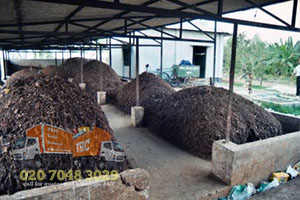Composting is an effective way to generate useful material from decaying organic matter. Composting at home is a great way to do your own green rubbish removal so to speak, as all decaying organic matter from the garden and the kitchen can be composted and turned into natural soil fertilisers.
However, composting is also done on an industrial scale, in this case farming scale. This process is known as windrow composting. The way windrow composting works is incredibly simple and also incredibly effective. Here is the entire windrow composting process from start to end:
 Households and businesses, parks and green open spaces etc. require green waste removal on a regular basis. Dead plant matter from gardens, backyards and parks, as well as any other organic scraps and leftovers from domestic and commercial kitchens can all be used for compost. Biological waste (faecal matter) however is not to be used.
Households and businesses, parks and green open spaces etc. require green waste removal on a regular basis. Dead plant matter from gardens, backyards and parks, as well as any other organic scraps and leftovers from domestic and commercial kitchens can all be used for compost. Biological waste (faecal matter) however is not to be used.
When using a specialised green rubbish removal service, it is more than likely that the service provider you engaged will give green waste for windrow composting. Large waste removal companies that deal specifically with green waste may also have their own windrow composting facilities.
The windrow composting process is quite simple. Green waste is grinded down (if necessary) to a homogenous mass. The mass looks similar to soil and mud though it doesn’t smell as nice. The compost is mixed, turned and blended over and over again by special machines called windrow turners. The windrow turners are similar to bulldozers though they have different equipment attached to them. The machine operator has the task of blending warmer and cooler portions of the compost heap using the turner. Keeping constant track of temperature on the surface and on the inside of the mixture is crucial in order to get quality compost fast.
The turning process also distributes evenly the amounts of carbon and nitrogen contained in compost thus making it even more fertile. Turning also allows moisture to evaporate as composting is much more than controlled rotting, meaning it doesn’t involve any moisture.
Once the heaps of mixture are turned and blended properly, the turner operator will use the machine to spread the mix in large rows. The rows are lined in large, open air spaces and allowed to compost naturally. The turner machine also oxygenates the mixture through ruffling the surface of the compost mix with special equipment. The mechanics of the oxygenation process also allow for waste gasses to evaporate from the compost mix.



